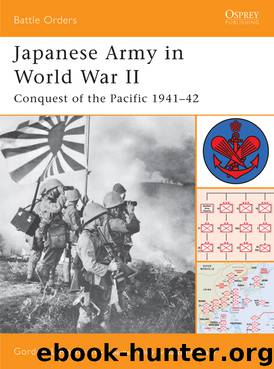Japanese Army in World War II by Gordon Rottman

Author:Gordon Rottman
Language: eng
Format: epub
Tags: Japanese Army in World War II: Conquest of the Pacific 1941–42
ISBN: 9781272804679
Publisher: Osprey Publishing Ltd
Small-unit tactics in the Philippines
A number of characteristics of Japanese small-unit tactics were noted in the Philippines. Attacks would often begin at dusk with infiltration through gaps between units and flank attacks. After securing as much ground as possible before complete darkness, they consolidated and prepared defenses for an enemy dawn counterattack. Even though many Japanese battalions had suffered heavy losses during the Bataan assaults, they would strive to keep up pressure on US–Filipino positions, constantly seeking out gaps and weak points. When these were found, they would immediately infiltrate them, to be followed by supporting troops in the hope of establishing a foothold within the US–Filipino position. Harassment of frontline positions was constant with infiltration by individuals and small groups, sniper fire, probes from unexpected directions, and sections frequently opening fire intermittently—all to cause confusion and uncertainty. This was also an effort to draw fire to locate US–Filipino positions. On several occasions the Japanese rapidly occupied abandoned villages and brought in troops by truck, with the result that they received heavy enemy artillery fire. From this they learned to bring troops in through the jungle on foot, and to remain dispersed and concealed.
Japanese artillery tactics were initially ineffective, as they had little experience against an artillery-armed enemy. The camouflage of gun positions was poor and companies were positioned too close together, making them vulnerable to counterbattery fire. They learned quickly though, concealing their guns better and dispersing firing units more widely. They would sometimes employ a single artillery piece to range a target, and then move in a company to accomplish the fire mission; meanwhile the single gun moved to another position, repeated its ranging task for another target, with the company following on quickly to accomplish the next mission.
One American officer commented, “The Japanese are crafty, shrewd, given to deception. They are amazingly patient and wait for hours, even days, for their chance. They are tough individual soldiers and work well in small groups of two or three men.”
Download
This site does not store any files on its server. We only index and link to content provided by other sites. Please contact the content providers to delete copyright contents if any and email us, we'll remove relevant links or contents immediately.
| Africa | Americas |
| Arctic & Antarctica | Asia |
| Australia & Oceania | Europe |
| Middle East | Russia |
| United States | World |
| Ancient Civilizations | Military |
| Historical Study & Educational Resources |
The Sympathizer by Viet Thanh Nguyen(4104)
The Rape of Nanking by Iris Chang(4032)
World without end by Ken Follett(3352)
Ants Among Elephants by Sujatha Gidla(3284)
Blood and Sand by Alex Von Tunzelmann(3072)
Japanese Design by Patricia J. Graham(3012)
City of Djinns: a year in Delhi by William Dalrymple(2441)
Foreign Devils on the Silk Road: The Search for the Lost Treasures of Central Asia by Peter Hopkirk(2393)
Inglorious Empire by Shashi Tharoor(2349)
The Queen of Nothing by Holly Black(2342)
India's Ancient Past by R.S. Sharma(2315)
In Order to Live: A North Korean Girl's Journey to Freedom by Yeonmi Park(2306)
Tokyo by Rob Goss(2299)
India's biggest cover-up by Dhar Anuj(2256)
Tokyo Geek's Guide: Manga, Anime, Gaming, Cosplay, Toys, Idols & More - The Ultimate Guide to Japan's Otaku Culture by Simone Gianni(2248)
The Great Game: On Secret Service in High Asia by Peter Hopkirk(2237)
Goodbye Madame Butterfly(2168)
Batik by Rudolf Smend(2015)
Living Silence in Burma by Christina Fink(1993)
